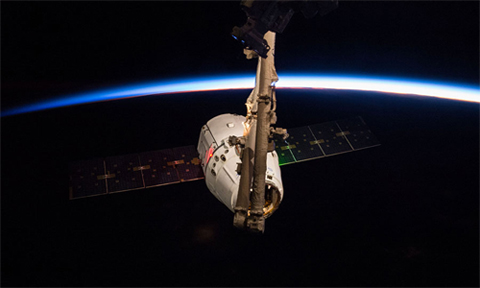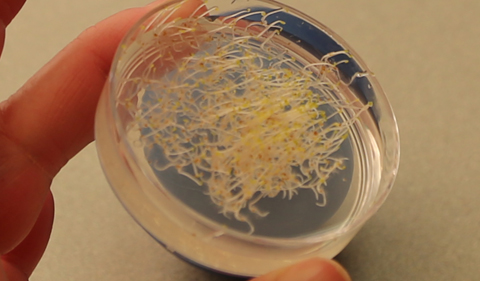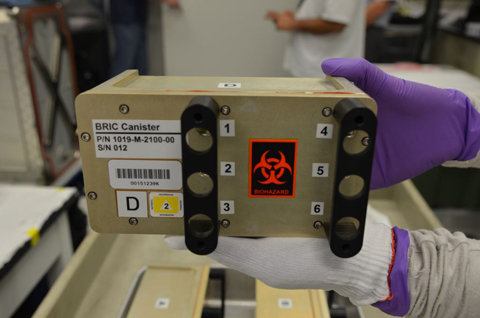
Expedition 42 commander and NASA astronaut Barry Wilmore and European Space Agency astronaut Samantha Cristoforetti used the Canadarm2 robotic arm to grapple the SpaceX Dragon (CRS-5) ship on Jan. 12 2015, two days after its launch from the Cape Canaveral Air Force Station, Florida. Dragon was attached to the station’s Harmony module three hours after it was grappled, where it spent a month being unloaded.
Image Credit: NASA
Watch live as the Ohio University experiment leaves the International Space Station today, Feb. 10, at 2 p.m. on NASA TV.
Coverage beings at 12:45 p.m., and the release of the SpaceX/Dragon Cargo Ship from the the space station is scheduled at 2:10 p.m. ET.
The Expedition 42 crew closed the hatches to the Dragon commercial cargo craft yesterday after loading it with critical gear and research. Dragon will be unberthed from the Harmony module then released from the grips of the Canadarm2 this afternoon. It will splashdown off the Pacific coast of Baja California for recovery by SpaceX engineers a couple of hours before sunset, according to the Space Station blog.
The Dragon space freighter will splash down off the Pacific coast of Baja California loaded with research and gear for analysis on Earth—including research modules in cold bags headed to Dr. Sarah Wyatt’s genetics lab in the Environmental & Plant Biology.
After the cargo craft returns to Kennedy and the experiment is “deintegrated,” a truck will overnight the experiment canister to Ohio University by Wednesday, Feb. 10, at 10 a.m. Wyatt will fly to Kennedy for the deintegration, then fly back to Ohio to accept the shipment in Athens.
OHIO Team Gravitron Experiment
Ohio University’s Team Gravitron plants-and-gravity experiment launched Jan. 10 and docked with the International Space Station today, Jan. 12.
Dr. Sarah Wyatt, Professor of Environmental & Plant Biology and principle investigator on the project, was at Kennedy preparing the canisters that will fly as well as the ground control experiment at Kennedy. Now she and her students await the arrival of the seeds that germinated aboard the space station.
In her lab in Porter Hall, Wyatt and her students will extract proteins from the germinated seedlings, and those samples will be sent to Danforth Research Center near St. Louis for the mass spectrometry proteomics analysis. They are studying the signal-induced gravitropic response in Arabidopsis thaliana.
“We’re looking for protein identification and qualification,” Wyatt says. “It breaks the compounds up, and then you can match up the fragments with known proteins so you can identify what proteins are there. And the mass spectrometry also gives you a relative quantity of the proteins.”
The ground control and space-flight samples will be analyzed for protein expression. The variable between the samples is called “space-flight environment,” where micro-gravity and other factors such as radiation impact the space station environment.
“I’m expecting that we’re going to see differences, especially in the post-translation or modification of proteins that are trying to respond to gravity—or they’re not responding because they have no gravitational signal to respond to.”
“I’m trying to figure out what the signal is here on Earth, and on Earth you can’t really figure that out because you don’t have the control.” What Wyatt expects to find—within an already transcribed gene—is a protein getting turned on and turned off in response to the gravity signal.

This is what the Arabidopsis thaliana seeds look like when they germinate. They do not have color because they have not been exposed the light (prior to the photo).
How Do Plants Know Which Way is Up?
Gravity. Not the sun. Plants do not grow “up” because they are attracted to sunlight. They grow up because they are responding to gravity.
On the International Space Station, Wyatt’s Arabidopsis thaliana seeds germinated and grew in the dark. A control lab at Kennedy—and one in the Wyatt lab—mirrored the space conditions—with gravity as the main variable.
When seedlings germinate in the soil, gravitational signaling tells them which way to grow, and it was that gravitropic signaling that Wyatt began exploring about 15 years ago. At that time, scientists knew almost nothing about how plants “signaled” gravity. Now hers is one of only a few labs in the world—including one in Wisconsin and one in Japan—studying how plants respond to gravity.




















Comments